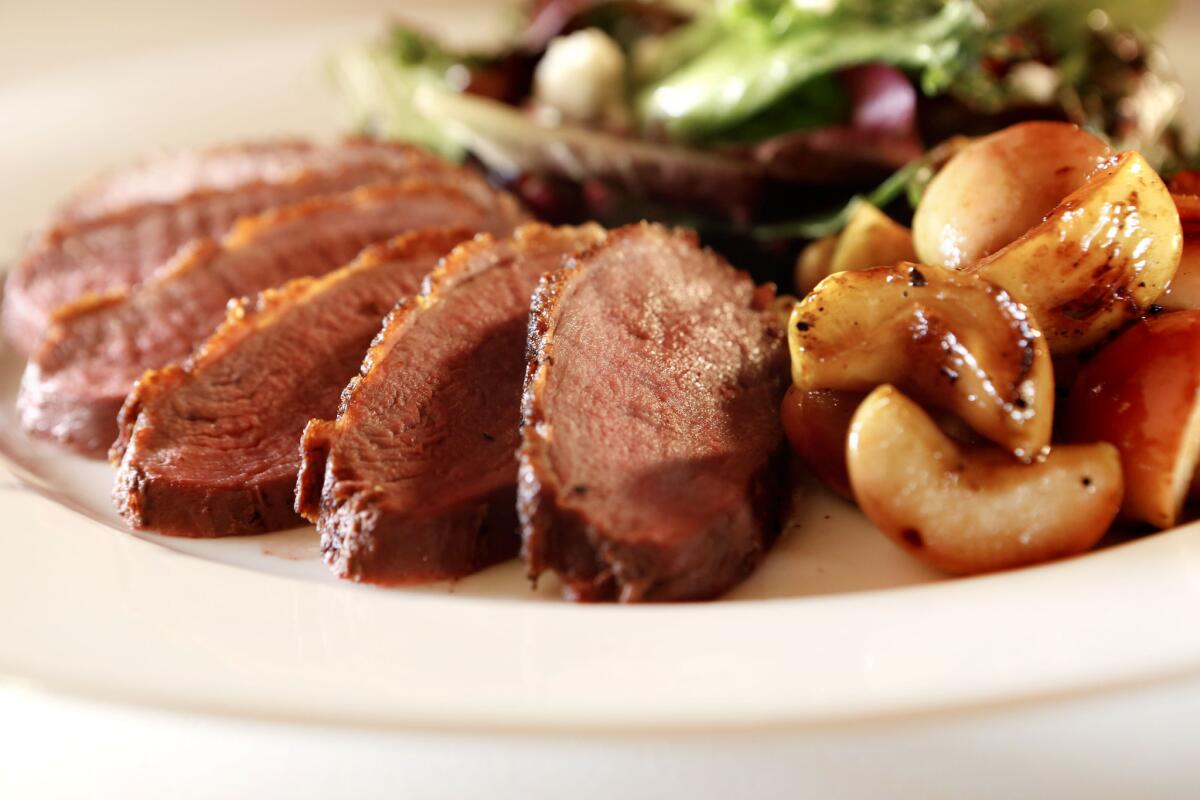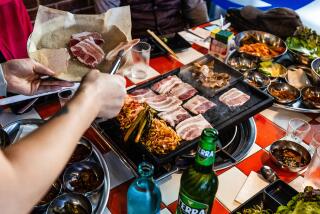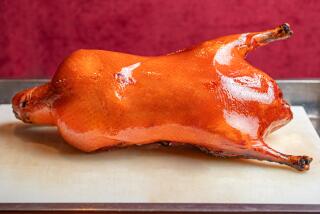Cooking with duck is simpler than you think

Sauteed duck breast with apples and tart greens in the Los Angeles Times studio on Oct. 8, 2015.
- Share via
So you’ve ordered Roy Choi’s killer smoked duck at Pot in Koreatown. And you’ve beaten the French bistro crowds for the duck confit at Republique or Church & State — or the duck ragout at Maccheroni Grill in downtown L.A., if you prefer your duck in Italian. And you’ve even hit the best of the duck barbecue places elsewhere in Koreatown and the San Gabriel Valley. Still, there comes a point when you need to eat dinner in your own kitchen.
If you love the particular richness of duck — it’s more assertive than the blank canvas of chicken — but you’ve never tried to tackle it at home, it’s not as hard as you might think.
Shop for duck at your local supermarket, and odds are you’ll find the whole bird cryovaced in the freezer section, a plastic orange sauce packet neatly stuffed into the cavity. Which is a shame, because there’s so much more to the bird than duck a l’orange. You could sear a duck breast in minutes for a quick dinner, or slowly braise duck legs in their own fat to succulent tenderness in the form of duck confit. Roast or barbecue the whole bird for a dramatic presentation for company, or conveniently forget about it for several hours in your slow cooker for a weeknight meal.
For the first-time cook, duck might come across as a little intimidating. Unlike chicken or turkey, duck is comprised of all dark meat, including the breasts. But duck is actually very forgiving in the kitchen. First, unlike other types of poultry, duck can safely be cooked to a lower temperature (because it doesn’t carry salmonella). Sear a duck breast to medium-rare and you’ll find it’s similar to steak in looks and flavor. And it cooks just as quickly.
And believe it or not, duck meat itself is surprisingly lean. All too often, duck is considered a “fatty” or “greasy” meat. While you will find a good layer of fat beneath the skin, it’s not difficult to remove or cook most of the fat out of the bird before serving. If you’ve ever enjoyed a seared duck breast, you’ll often find the crisp skin is marked with a crosshatch pattern. Slicing through the skin in this way before cooking allows the fat to drain out as the meat cooks. Likewise, when you roast a duck, you’ll often find instructions to pierce the skin with a fork before cooking; this also allows the fat to drain out easily without soaking the meat and skin.
If you’ve ever had Peking duck, you’ve likely, hopefully, appreciated its crackly crisp skin. The traditional preparation is involved and can take a few days to prepare, but there are ways to riff on the classic method to achieve many of the same results. On a traditional Peking duck the skin is inflated before cooking (picture a bicycle pump or perhaps a homemade rig involving a turkey baster); this allows the fat to drain down and out of the bird easily as it roasts. Instead of this, gently peel the skin away from the breasts and around the thighs of the bird, as this is where much of the fat is concentrated. Then ladle boiling water over the duck; this will melt some of the fat while tightening the skin itself. And be sure to chill the duck, uncovered, on a rack in the refrigerator overnight; the cold air will help to dry the skin out before roasting.
Finally, roast the duck vertically over an empty beer can chicken roaster. (Perhaps you’ve witnessed a beer can chicken: a whole chicken, wings casually folded behind the neck, propped up on a beer can or beer can roaster as it leisurely roasts on the grill.) Vertically roasting will cook the duck more evenly and help the fat to drain out of the bird, allowing the skin to crisp.
Duck fat is gold in the kitchen — so save it. Before cooking duck, remove any large fat pockets and render them gently over low heat until they melt, then strain to remove any solids. Duck fat will keep for months in the refrigerator or freezer. Use it in place of butter or other fats to flavor everything from vegetables to pie crusts.
While duck sometimes has the reputation of being a gamy meat, most of the duck sold in the U.S. is white Pekin, which is known for its mild flavor and tender texture. Still, duck can come across as a little heavier than other types of poultry. Consider adding bright and tart flavors when cooking or serving duck. Pair duck breast with stewed tart cherries or apple slices, or flavor whole duck with a rich pomegranate molasses rub before roasting. And instead of weighing the duck down in a heavy cassoulet or ragout, serve it alongside a simple salad with a light, acidic vinaigrette.
Oh, and as for that packet of orange sauce, you can toss it in the trash.
Twitter: @noellecarter
More to Read
Get our Cooking newsletter.
Your roundup of inspiring recipes and kitchen tricks.
You may occasionally receive promotional content from the Los Angeles Times.







